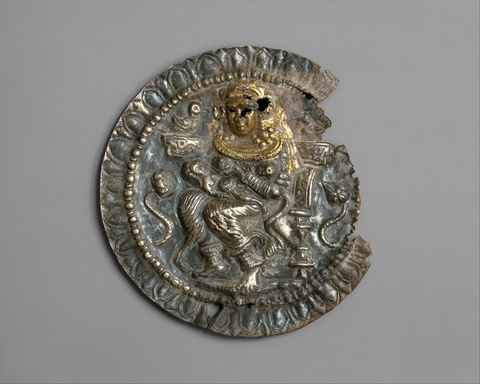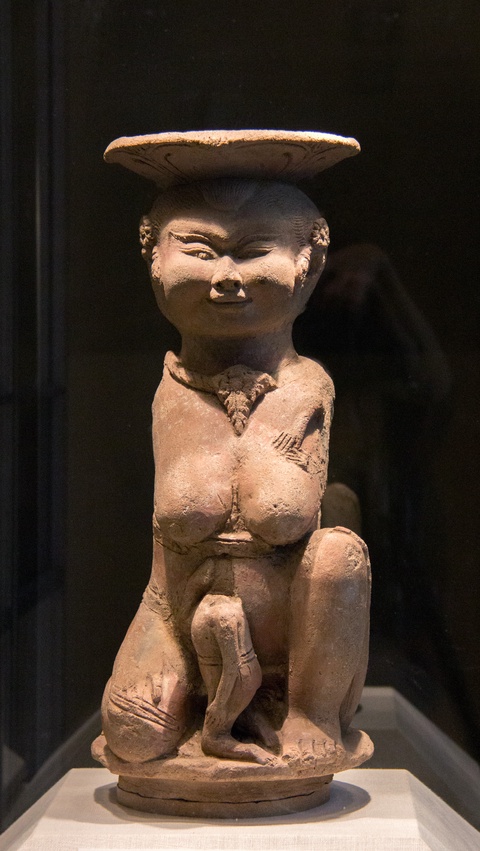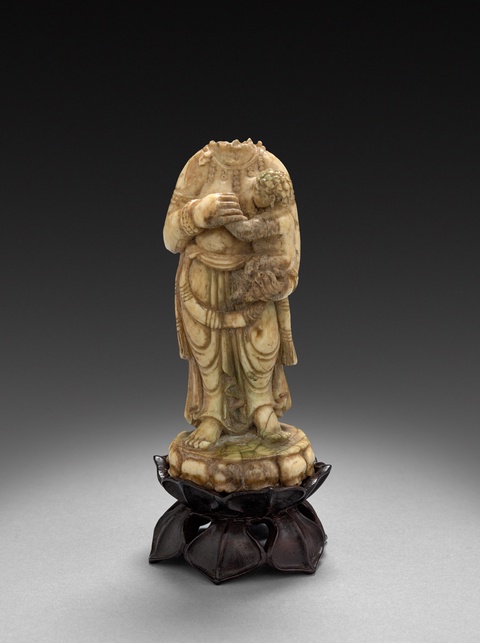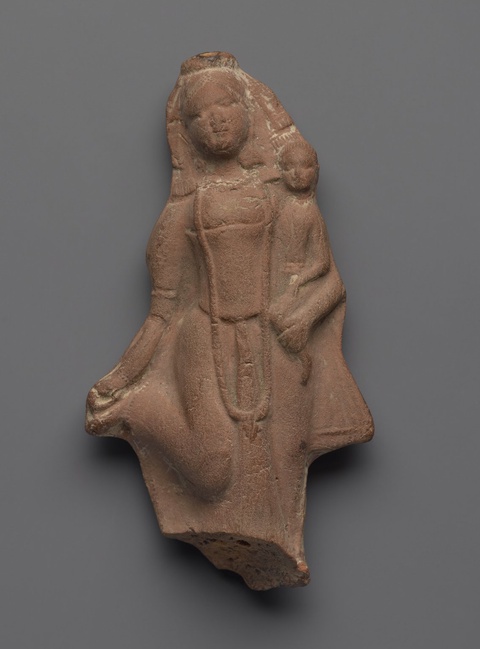Goddess Hariti: The Joy and Terror of Childbirth
By Reina Gattuso•September 2022•13 Minute Read
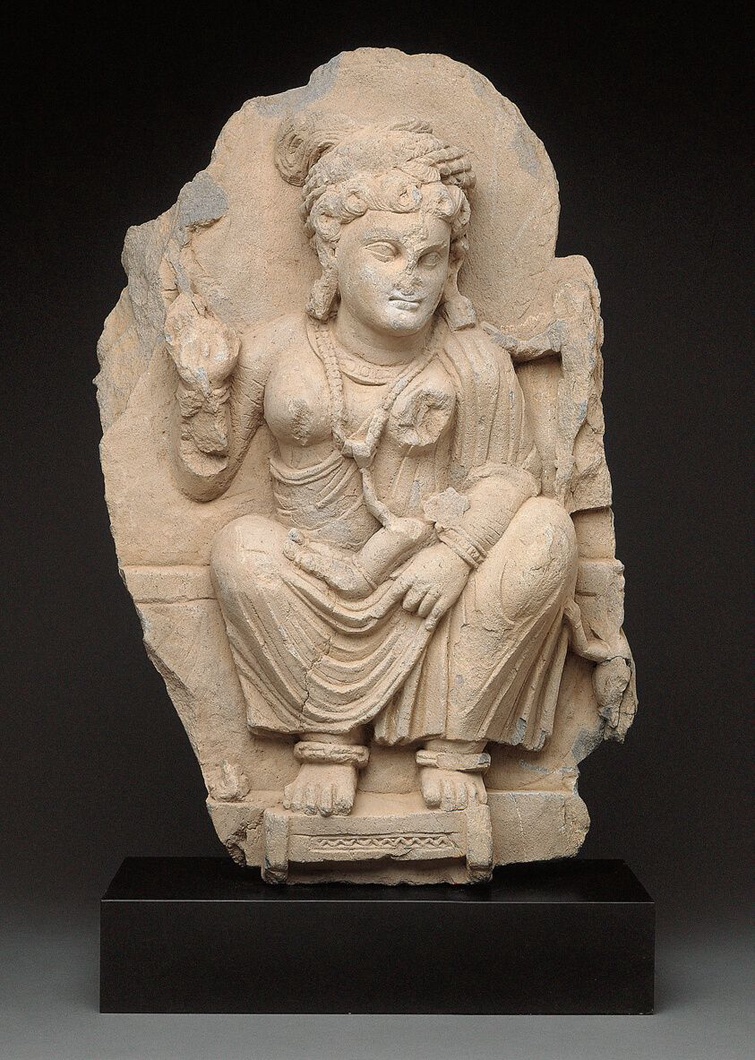
Unknown, Goddess Hariti Seated Holding a Child, 101 CE–300 CE. Art Institute of Chicago. A Gandharan sculpture of the goddess Hariti, seated and holding a child in her left arm while raising her right hand in a mudra.
The goddess Hariti is a feared child-snatcher as well as a bringer of abundant fertility. Her journey from volatile nature spirit to benevolent Buddhist deity spans thousands of years and as many miles. Paintings and sculptures of Hariti interpret her dual nature to reveal the joy and pain of childbirth.
Pregnancy and childbirth bring death as well as new life. The goddess Hariti, found in the Buddhist, Hindu, and Jain pantheons, represents the ambivalence of this experience. From unwanted pregnancy to miscarriage and infant death, people with uteruses experience deep vulnerability in reproduction. Women appeal to gods and spirits to ensure healthy pregnancies, prevent or abort unwanted ones, and guard infants against illness and accident. Hariti is one such deity.
Hariti is a yakshini, a nature spirit, arising from animist belief systems in South Asia. Some of her earliest mentions occur in Buddhist texts.1
In some versions of the story, a young woman miscarried a longed-for pregnancy. She later died and was reborn as a yakshini named Hariti. She was still filled with grief and rage from the miscarriage in her previous life, so she made it her mission to kidnap other women’s children. She mothered 500 children of her own by the yaksha Panchika and fed them the human babies she took. Some texts called her Bhutamata, the “mother of demons.”2 Women in ancient South Asia hoped to appease this angry deity to keep their children safe.
According to Buddhist myth, Hariti then met the Buddha and accepted his dharma. She renounced her child-snatching ways and became a protector of all children. Buddhists, Hindus, and Jains worshiped her. Hariti traveled across India and Southeast Asia with Buddhism and Hinduism. She melded with local mythology and iconography to assume many forms.3
People across Asia understood the joys and sorrows of motherhood differently. Hariti’s representations are as varied as the times and places in which she found popularity.
Hariti Enters the Archaeological Record
By the time Hariti sculptures entered the archaeological record, she had already been reformed through Buddhism. Images of Hariti first appear during the Kushan period in Gandhara, a region in the northwest of present-day Pakistan.
The Kushans, who ruled from the second century BCE to the third century CE, patronized Buddhism.4 Gandhara was an imperial crossroads where many groups traded, such as Parthians (from what is now Iran), Greeks, and groups from the Indian subcontinent.5 As a result, Kushan Buddhist art is syncretic. It mixes representations of local spirits with iconography borrowed from Greek and ancient Iranian deities.
A silver rondel is one of the earliest known depictions of Hariti.
The piece demonstrates syncretism in Hariti’s iconography. Art historians sometimes call her seated position, cradling her infant, the “Magna Mater” or “great mother” posture.6 It is common in mother goddess representations across cultures.7
The swans and lotuses shown surrounding Hariti, as well as her heavy jewelry, tie her to Hindu deities such as Lakshmi, goddess of prosperity.8

A stone carving of Hariti demonstrates Greek, Iranian, and Hindu influences. Her voluminous body and draped garment reflect conventions of Hellenistic sculpture.9
Historians argue that Hariti is related to the Greek goddess of good fortune, Tyche, as well as Ardochsho, a Kushan goddess with Iranan influences.10 In Kushan art, the goddess often raises her palm to the viewer in what seems to be the abhaya mudra, a convention of Hindu iconography that reminds the viewer to be without fear.
Hariti is sometimes shown alongside a male figure. This may be her consort Panchika, who fathered 500 children with her. The male figure could also be Kubera, king of the yakshas, a Kushan and Buddhist deity of good fortune and wealth. Some traditions equate Panchika and Kubera.11
Hariti’s Influence Spreads
Starting in the Kushan period, Buddhist monks kept idols of Hariti in their monasteries. Visitors gave Hariti offerings. Buddhist monasteries were often centers of medical knowledge, and offered care for pregnant people.12 Hariti may have symbolized both general abundance and specific protection for pregnancy and childbirth.13
South Asian Hindus and Jains also adapted the worship of Hariti. Jains referred to Hariti as Bahuputrika.14 The goddess’s popularity spread alongside both Buddhism and Hinduism. She gained new names as she traveled and syncretized with local goddesses. Artists as far afield as India, Indonesia, and China drew on local conventions to represent her.
India
Rulers of the Pala empire, which extended from current-day central India through current-day Bangladesh, supported Buddhism. Their patronage encouraged a unique school of Buddhist art, which included sculptures of Hariti.14 Sculptures of Hariti typically sat in temple niches to be worshiped by devotees.

Artists depicted Hariti surrounded by her children, with the large breasts, small waist, and thick, jeweled girdle typical of Hindu goddesses associated with prosperity and fertility. She assumes a seated posture with one leg out, called lalitasana. The posture is a mark of royalty and sacredness in both Buddhist and Hindu iconography.15
Indonesia
Traders, traveling scholars, and priests brought Hinduism to Indonesia by around the 1st century CE.16 Some Indonesian rulers began to favor Hinduism by the fourth century CE.17 Monks used maritime trade routes to spread Buddhism to Indonesia by the fifth century CE, if not earlier.18
Hariti traveled with them. Artists depicted the goddess’s Indonesian Hindu form, Men Brajut (also spelled Brayut), in temple art of the Majapahit Empire.19 20
Men Brajut’s iconography also includes small children and infants. Her image adorned temples in East Java.21
Indonesian artists represented Men Brayut and her husband Pan Brayut (Panchika) as protectors of children. Yet they often included some demon-like features, demonstrating that the couple’s yaksha origins remained important to their worshippers.22
Chinese Buddhism
Traveling monks brought Buddhism to China in the second century CE. Buddhism entered a rich mix of local spiritual practices, including Confucianism and Daoism.23 By the sixth century CE, Buddhism was very popular in China.
Chinese Buddhists called Hariti “Guizimu,” or “mother of demons.” In Chinese myth, Guizimu often has 10,000 children with Panchika, rather than 500.
In China, the story of Guizimu’s conversion to Buddhism became a popular theme for painting.24
In the story’s popular telling, local mothers in Rajgir in northern India, terrorized by Guizimu’s child-stealing, complained to the Buddha. The Buddha kidnapped and hid one of Guizimu’s children beneath his alms bowl in order to teach her a lesson. Guizimu went wild with grief. She tried to lift the alms bowl by force, but couldn’t.
Guizimu recruited an army of other demons to lift the bowl. They also failed. It was only when Guizimu renounced child-stealing and accepted Buddhism that she could lift the bowl and be reunited with her child.
Colonial India
Even after Buddhism lost influence in India around the 12th century CE, images of Hariti remained popular in Hindu art and folk traditions. Her status as a mother goddess made her ever-adaptable in popular imagination.
Mathura Hariti
In this terracotta plaque, perhaps from a temple, we can recognize Hariti from the child in her hands. She lifts her foot to pull a thorn from it, a common pose of yakshinis, apsaras (heavenly feminine spirits), and other youthful beauties in Indian art.27
Sitala, Mother of Pox
Worshippers appealed to Hariti to protect babies from childhood illnesses.28 In some regions of South Asia, worshippers considered her a protector of children against smallpox.29
Because of this, some scholars and worshippers equate Hariti with Sitala Devi, the north Indian goddess of smallpox.30 31 Sitala is also associated with malaria, blood infections, and other contagious diseases.
Sitala possibly started as a local adivasi (tribal or indigenous) goddess whose worship was adapted by local Buddhists.32 She remains largely a folk goddess, worshiped on the local level to prevent and cure disease.
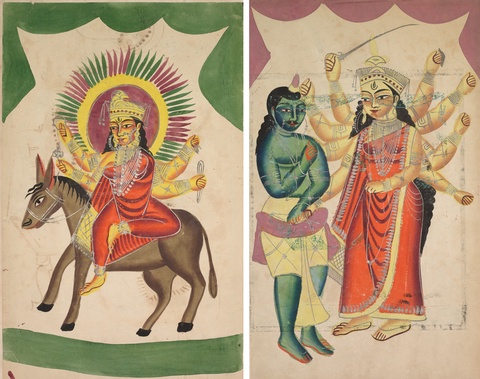
Artists of the Bengali Kalighat school painted Sitala Devi. The goddess sits in lalitasana, signifying she is sacred. Her vahana, or vehicle, is a donkey, considered an inauspicious animal.
In some depictions, Sitala carries a broom to sweep illness—either away from or toward humans. She carries a jug of water to wash away illness and hydrate the sick. When Sitala does bring disease, people hope to appease her so she’ll grant relief. This practice evokes the dual nature of Hariti as both afflictor and protector of children.
In 2020, many Sitala devotees prayed to her to eradicate COVID-19.33 34 Some Hindus consider COVID-19 itself a goddess. They worshiped her in the hopes of ending the pandemic. Others saw COVID-19 as a demon. For example, many of the potters who make idols for the yearly celebration of Durga Puja in West Bengal in 2020 replaced the image of the demon Mahishasura with the demon “Coronasura.” They hoped the Hindu goddess Durga would crush the coronavirus demon.35
This dual representation of coronavirus is similar to that of Hariti herself. Are Coronadevi, Sitala, and Hariti deities or demons? Or, as many Dalit, adivasi, and anticaste activists argue, are demons simply the deities of marginalized people, who have not been accepted in the elite pantheon?
Hariti Today
Sitala Ma represents the core contradiction of Hariti. She is both the illness and the cure; both the deity who snatches children and the one who protects them. She must be adored in order to prevent her wrath.
While smallpox has been eradicated, the goddess’s work isn’t over. The COVID-19 pandemic has painfully illustrated that humans remain vulnerable to the whims of disease. At the same time, widespread inequality in healthcare make unwanted miscarriage and infant death persistent fears. Even with the best modern medicine, pregnancy and childbirth still carry an aspect of fate.
Neither the Buddha, in his efforts to tame Hariti, nor modern medicine, in its efforts to eradicate disease, have been able to eliminate the ambivalence of childbirth. Ultimately, all who give birth remain at goddess Hariti’s whim.
Reina Gattuso is a content writer on the Curationist team, and an independent journalist covering gender and sexuality, arts and culture, and food. Her journalism connects analysis of structural inequality to everyday stories of community, creativity, and care. Her work has appeared at Atlas Obscura, The Washington Post, Teen Vogue, The Lily, POPSUGAR, and more. Reina has an MA in Arts and Aesthetics (cinema, performance, and visual studies) from Jawaharlal Nehru University in New Delhi, India, where her research focused on sexuality in Hindi film. She writes and teaches writing to high school students in New York City.
Suggested Readings
Nagarkar, Tishyarakshita A. and American Institute of Indian Studies. “From Demoness to Deity: Hariti in Art and Familial Traditions.” Google Arts and Culture, artsandculture.google.com/story/from-demoness-to-deity-hariti-in-art-and-familial-traditions-american-institute-of-indian-studies/lQXR8A221T6bLA?hl=en.
Ahuja, Naman. Live History India, 16 August 2019, www.livehistoryindia.com/story/living-culture/gandharas-goddess-hariti-bridging-faiths.
Hemingway, Colette and Seán Hemingway. “Art of the Hellenistic Age.” The Metropolitan Museum of Art, April 2007, www.metmuseum.org/toah/hd/haht/hd_haht.htm.
Dehejia, Vidya. “Recognizing the Gods.” The Metropolitan Museum of Art, February 2007, www.metmuseum.org/toah/hd/gods/hd_gods.htm.
Dasgupta, Deepsikha. “New Diseases, Old Deities: Revisiting Sitala Maa during COVID-19 Pandemic in Bengal.” National University of Singapore, 11 February 2021, ari.nus.edu.sg/20331-75/.
Das, Madhuparna. “Durga to slay ‘Coronasura’ this year as Kolkata artisans theme their idols on pandemic.” The Print, 13 September 2020, theprint.in/india/durga-to-slay-coronasura-this-year-as-kolkata-artisans-theme-their-idols-on-pandemic/501319/.
Citations
“Pali canon.” Britannica, 22 March 2019, www.britannica.com/topic/Tipitaka. Accessed 17 March 2022.
Sarkar Banerjee, Radha. “Hariti, Buddhist Deity.” Indira Gandhi National Centre for the Arts, ignca.gov.in/PDFdata/HaritiBuddhist_deity.pdf. Accessed 17 March 2022.
Nagarkar, Tishyarakshita A. and American Institute of Indian Studies. “From Demoness to Deity: Hariti in Art and Familial Traditions.” Google Arts and Culture, artsandculture.google.com/story/from-demoness-to-deity-hariti-in-art-and-familial-traditions-american-institute-of-indian-studies/lQXR8A221T6bLA?hl=en. Accessed 17 March 2022.
Behrendt, Kurt A. "The Art of Gandhara." The Metropolitan Museum of Art, 2007, www.metmuseum.org/art/metpublications/TheArtofGandharainTheMetropolitanMuseumof_Art. Accessed 17 March 2022.
Department of Asian Art. “Kushan Empire.” The Metropolitan Museum of Art, October 2000, www.metmuseum.org/toah/hd/kush/hd_kush.htm. Accessed 17 March 2022.
Ahuja, Naman. "Gandhara's Goddess Hariti — Bridging Faiths." Live History India, 15 August 2019, www.livehistoryindia.com/story/living-culture/gandharas-goddess-hariti-bridging-faiths. Accessed 17 March 2022.
"Gandhara's Goddess Hariti — Bridging Faiths."
Nagarkar, Tishyarakshita A. and American Institute of Indian Studies. “Sri Lakshmi: The Goddess of Fortune and Prosperity.” Google Arts and Culture, artsandculture.google.com/story/sri-lakshmi-the-goddess-of-fortune-and-prosperity-american-institute-of-indian-studies/LAXx7bdMwSeBKA?hl=en. Accessed 17 March 2022.
Hemingway, Colette and Seán Hemingway. “Art of the Hellenistic Age.” The Metropolitan Museum of Art, April 2007, www.metmuseum.org/toah/hd/haht/hd_haht.htm. Accessed 17 March 2022.
“Ardochsho.” The British Museum, www.britishmuseum.org/collection/term/BIOG132101. Accessed 17 March 2022.
“Kubera.” Wikipedia, en.wikipedia.org/wiki/Kubera. Accessed 23 March 2022.
"Gandhara's Goddess Hariti — Bridging Faiths."
Padma, Sree. “Hariti: Village Origins, Buddhist Elaborations, and Saivite Accommodations.” Asian and African Area Studies, vol. 11, no. 1, 2011, pp.1-17, www.asafas.kyoto-u.ac.jp/dl/publications/no1101/AA1111_sree.pdf. Accessed 17 March 2022.
“From Demoness to Deity: Hariti in Art and Familial Traditions.”
“Sculpture of the Pala Period.” Asia Society, www.asiasocietymuseum.org/region_results.asp?RegionID=1&CountryID=1&ChapterID=4. Accessed 17 March 2022.
Dehejia, Vidya. “Recognizing the Gods.” The Metropolitan Museum of Art, February 2007, www.metmuseum.org/toah/hd/gods/hd_gods.htm. Accessed 17 March 2022.
Juergensmeyer, Mark and Wade Clark Roof. Encyclopedia of Global Religion, Volume 1, SAGE Publications, 2012, p. 557. Google Books, www.google.com/books/edition/EncyclopediaofGlobal_Religion/B105DQAAQBAJ?hl=en&gbpv=1&pg=PA557&printsec=frontcover. Accessed 17 March 2022.
Klokke, Marijke J. “Hinduism and Buddhism in Indonesia.” Worshiping Siva and Buddha: The Temple Art in East Java, Ann R. Kinney, Lydia Kieven and Marijke J. Klokke, eds., University of Hawai’i, 2003, pp. 17. Google Books, www.google.com/books/edition/WorshipingSivaand_Buddha/sfa2FiIERLYC?hl=en&gbpv=1. Accessed 17 March 2022.
“Hinduism and Buddhism in Indonesia.”
“Majapahit Empire.” Britannica, May 2012, www.britannica.com/place/Majapahit-empire. Accessed 17 March 2022.
“Fifteen terra-cotta figures.” National Museum of Asian Art, asia.si.edu/collections/new/acquisitions-2017/s2017-8-15/. Accessed 17 March 2022.
“The Mother Goddess Men Brajut.” The Metropolitan Museum of Art, www.metmuseum.org/art/collection/search/75279. Accessed 17 March 2022.
Boeles, J.J. “The Buddhist Tutelary Couple Hariti and Panchika, Protectors of Children, From a Relief in the Khmer Sanctuary in Pimai.” Journal of the Siam Society, vol. 56, no. 2, 1968, pp. 187-205, thesiamsociety.org/wp-content/uploads/1968/03/JSS0562c_BudhistTutelaryCoupleHaritiAndPancikaInPimai.pdf. Accessed 17 March 2022.
Foy, Geoff. “Buddhism in China.” Asia Society, asiasociety.org/buddhism-china. Accessed 17 March 2022.
Tothill, Vanessa. “The Sutra of the Demon-Mother told by the Buddha.” Maidstone Museum, 19 October 2016, museum.maidstone.gov.uk/sutra-demon-mother-told-buddha/. Accessed 17 March 2022.
Murray, Julia K. “Representations of Hāritī, the Mother of Demons, and the Theme of ‘Raising the Alms Bowl’ in Chinese Painting.” Artibus Asiae, vol. 43, no. 4, 1981, pp. 253-284. JSTOR, www.jstor.org/stable/3249844. Accessed 17 March 2022.
“Mathurā Art.” Britannica, 29 April 2020, www.britannica.com/topic/Mathura-art. Accessed 17 March 2022.
Poster, Amy G. “Standing Female.” From Indian Earth, The Brooklyn Museum, 1986. Hathi Trust https://babel.hathitrust.org/cgi/pt?id=mdp.39015034690399&view=1up&seq=7&skin=2021. Accessed 7 April 2022.
Bhandare, Shailendra. “Pandemics and Protection—The Goddess Hariti.” Ashmolean Museum Oxford, www.ashmolean.org/article/pandemics-and-protection. Accessed 17 March 2022.
Padma, Sree. “Hariti: Village Origins, Buddhist Elaborations, and Saivite Accommodations.” Asian and African Area Studies, vol. 11, no. 1, 2011, pp.1-17, www.asafas.kyoto-u.ac.jp/dl/publications/no1101/AA1111_sree.pdf. Accessed 17 March 2022.
Sanford, A. Whitney. “Shifting the Center: Yaksas on the Margins of Contemporary Practice.” Journal of the American Academy of Religion, vol. 73, no. 1, March. 2005, pp. 89-110, www.jstor.org/stable/4139878. Accessed 17 March 2022.
Bhattacharya, Bibek. “The Cold Ones: India’s Epidemic Goddesses.” Mint, 17 April 2020, www.livemint.com/mint-lounge/features/the-cold-ones-india-s-epidemic-goddesses-11587104247592.html. Accessed 17 March 2022.
Ghatak, Proggya. “The Sitala Saga: A Case of Cultural Integration in the Folk Tradition of West Bengal.” Rupkatha Journal on Interdisciplinary Studies in Humanities, 26 October 2013, rupkatha.com/the-sitala-saga/. Accessed 17 March 2022.
Dasgupta, Deepsikha. “New Diseases, Old Deities: Revisiting Sitala Maa during COVID-19 Pandemic in Bengal.” National University of Singapore, 11 February 2021, ari.nus.edu.sg/20331-75/. Accessed 17 March 2022.
Samanta, Sanchari. “How a goddess called Corona came to be worshiped in West Bengal.” The Hindu, 11 June 2020, www.thehindu.com/society/a-goddess-called-corona-devi/article31795320.ece. Accessed 17 March 2022.
Das, Madhuparna. “Durga to slay ‘Coronasura’ this year as Kolkata artisans theme their idols on pandemic.” The Print, 13 September 2020, theprint.in/india/durga-to-slay-coronasura-this-year-as-kolkata-artisans-theme-their-idols-on-pandemic/501319/. Accessed 17 March 2022.
Reina Gattuso is a content writer on the Curationist team, and an independent journalist covering gender and sexuality, arts and culture, and food. Her journalism connects analysis of structural inequality to everyday stories of community, creativity, and care. Her work has appeared at Atlas Obscura, The Washington Post, Teen Vogue, The Lily, POPSUGAR, and more. Reina has an MA in Arts and Aesthetics (cinema, performance, and visual studies) from Jawaharlal Nehru University in New Delhi, India, where her research focused on sexuality in Hindi film. She writes and teaches writing to high school students in New York City.
